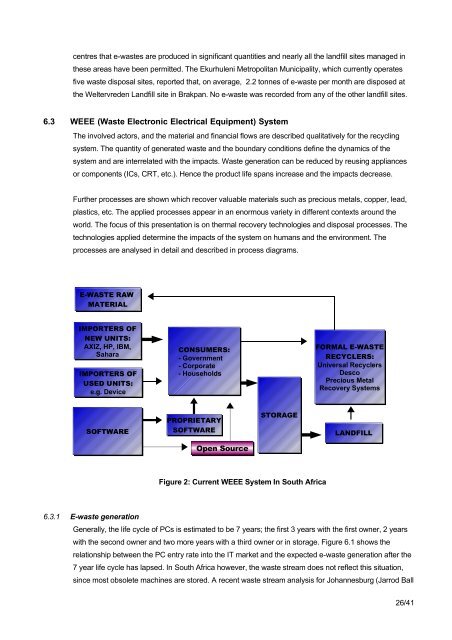E-WASTE ASSESSMENT IN SOUTH AFRICA - e-Waste. This guide
E-WASTE ASSESSMENT IN SOUTH AFRICA - e-Waste. This guide
E-WASTE ASSESSMENT IN SOUTH AFRICA - e-Waste. This guide
You also want an ePaper? Increase the reach of your titles
YUMPU automatically turns print PDFs into web optimized ePapers that Google loves.
centres that e-wastes are produced in significant quantities and nearly all the landfill sites managed inthese areas have been permitted. The Ekurhuleni Metropolitan Municipality, which currently operatesfive waste disposal sites, reported that, on average, 2.2 tonnes of e-waste per month are disposed atthe Weltervreden Landfill site in Brakpan. No e-waste was recorded from any of the other landfill sites.6.3 WEEE (<strong>Waste</strong> Electronic Electrical Equipment) SystemThe involved actors, and the material and financial flows are described qualitatively for the recyclingsystem. The quantity of generated waste and the boundary conditions define the dynamics of thesystem and are interrelated with the impacts. <strong>Waste</strong> generation can be reduced by reusing appliancesor components (ICs, CRT, etc.). Hence the product life spans increase and the impacts decrease.Further processes are shown which recover valuable materials such as precious metals, copper, lead,plastics, etc. The applied processes appear in an enormous variety in different contexts around theworld. The focus of this presentation is on thermal recovery technologies and disposal processes. Thetechnologies applied determine the impacts of the system on humans and the environment. Theprocesses are analysed in detail and described in process diagrams.E-<strong>WASTE</strong> RAWMATERIALIMPORTERS OFNEW UNITS:AXIZ, HP, IBM,SaharaIMPORTERS OFUSED UNITS:e.g. DeviceCONSUMERS:- Government- Corporate- HouseholdsFORMAL E-<strong>WASTE</strong>RECYCLERS:Universal RecyclersDescoPrecious MetalRecovery SystemsSOFTWAREPROPRIETARYSOFTWARESTORAGELANDFILLOpen SourceFigure 2: Current WEEE System In South Africa6.3.1 E-waste generationGenerally, the life cycle of PCs is estimated to be 7 years; the first 3 years with the first owner, 2 yearswith the second owner and two more years with a third owner or in storage. Figure 6.1 shows therelationship between the PC entry rate into the IT market and the expected e-waste generation after the7 year life cycle has lapsed. In South Africa however, the waste stream does not reflect this situation,since most obsolete machines are stored. A recent waste stream analysis for Johannesburg (Jarrod Ball26/41
















